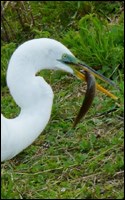
NPS photo Second only to the Great Blue Heron in size, the Great Egret (Casmerodius albus), sometimes called the Great White Egret, is one of the largest of the wading birds that inhabit the Everglades. Standing over 4 feet in height with a wingspan of more than 50 inches, it is similar in appearance to the Snowy Egret but can be distinguished by its long black legs, black feet, stout yellow bill, and tremendous size. The Snowy Egret is smaller than the Great Egret and has a black bill and yellow feet. The Great Egret also is often mistakenly identified as the Great White Heron, which is the white form of the Great Blue Heron. The heavier bill and pale legs of the Great White Heron are useful distinguishing characteristics. Like other herons, the Great Egret flies slowly and with its neck retracted, which is an easy way to distinguish it in flight from storks, cranes, ibises, and spoonbills, which extend their necks in flight. 
NPS photo The fishing habits of Great Egrets are among the most efficient of all birds. Great Egrets stalk their prey by slowly walking or standing motionless in the shallows and forage with their webbed feet, raking and probing the bottom, and snapping up fish in a matter of milliseconds with their quick bill reflex. In addition to fish, their diet includes invertebrates, amphibians, reptiles, other birds, and small mammals. They feed in a variety of wetlands, including marshes, swamps, streams, rivers, ponds, lakes, tide flats, canals, and flooded fields. Although Great Egrets are primarily solitary birds, they do congregate during mating season and can often be found nesting with other species in shrubs and trees over water. Both males and females exhibit long ornamental plumes during the mating season. Large numbers of Great Egrets were killed in North America, including the Everglades, around the end of the 19th century so that their plumes could be used to decorate hats. In the late 1800s naturalist John James Audubon visited the Everglades, where wading birds had been nesting for thousands of years. Public outrage was growing to put a stop to the mass commercial hunting of wading birds for the plume industry. Sporting one of the most popular plumages, the Great Egret became the symbol of the National Audubon Society, one of the oldest environmental organizations in North America, founded to protect all species of wading birds from being killed for their feathers. More than 300 Great Egrets were required to yield just one kilogram of feathers. Although numbers of Great Egrets have recovered throughout most of the United States in response to conservation measures, numbers have declined in some parts of the southern United States because of habitat loss. Data indicate that the Florida Everglades has undergone a 90-percent reduction in the number of breeding pairs of wading birds. Dwindling populations are a result of a combination of detrimental factors, most of them manmade, and many of them occurring outside the park boundary but strongly influencing bird populations within the park. Urbanization, water-management practices, pesticide application, agricultural runoff, industrial mercury and lead poisoning, illegal toxic-waste dumping, draining, dredging, and road building all have had a detrimental effect on wading bird habitat, and therefore population. The requested video is no longer available.
Additional Resources Please contact us for additional scientific reports |
Last updated: June 4, 2021
